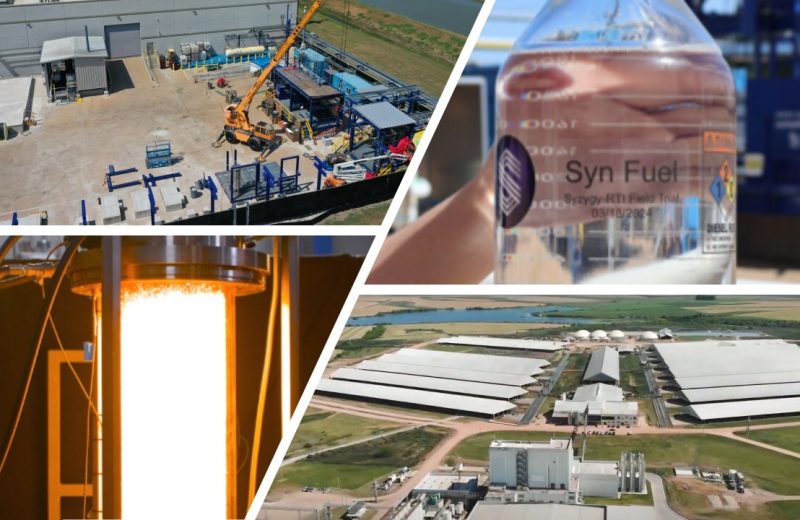Syzygy: Cows on a plane

Clockwise from top left: Demonstration plant enabling the project; fuel produced via Fischer-Tropsch and Syzygy technology at RTI; project site in Uruguay; powered-on RigelTM reactor.
They look sweet standing in meadows eating grass but on average cows kill 22 Americans every year. Sharks kill four people worldwide.
A single adult cow can also emit 500 litres of methane every day (both from burping and from the other end). The world’s 1.4bn beef and dairy cows account for 14.5% of total greenhouse emissions.
Cows are already vegans so there isn’t much that can be done about their diet. But their methane emissions could make sustainable aviation fuel (SAF). Syzygy Plasmonics says it has found a way to do so at a low cost.
“If you really want to disrupt the fuels and chemicals industries, you need to do something disruptive. Iterative improvements aren’t going to get us there,” says Trevor Best, CEO, speaking to SAF Investor. “Syzygy is bringing to market a solution that is dramatically different from other pathways, not just in terms of technology, but also in terms of economics and feedstock availability as well.”
At the heart of Syzygy Plasmonics’ solution is its NovaSAF platform which it says can convert this farm manure and landfill leftovers into SAF at a significantly lower price. The economics look surprisingly robust.
In its recently published white paper, Syzygy claims it can produce SAF at a cost of approximately $6 per gallon in the US. This puts SAF on a par with current jet fuel and dramatically cheaper than other pathways whose production costs range between $9 and $13 per gallon.
“Under the right conditions, we can achieve Jet A parity without any kind of notable credit support or mandate,” says Best. This, he says, is possible because Syzygy platform uses biogas from landfills, dairy farms and wastewater treatment plants which is currently not being used for anything else while simultaneously delivering higher yields from its low-cost technology.
While the theory may be sound, the proof lies in production. The company’s first commercial demonstration, in Durazno, Uruguay, will convert manure from 14,000 Uruguayan cows into nearly 400,000 gallons of SAF annually. Syzygy is utilising technology from Velocys and EPC solutions from Kent for the project.
The NovaSAF platform is a three-step process. First, biogas from the dairy farm will be treated in light-driven Rigel reactor, where renewable electricity (from Uruguay’s national grid with 90% coming from renewable sources) helps convert methane and CO2 into syngas. This then continues with established Fischer-Tropsch technology that turns gas into liquid hydrocarbons, before conventional upgrading processes create SAF.
“For the biogas to syngas portion, we’re going to be able to realise capex reductions of like 30-50%,” Best notes. The reactor technology operates using low-cost materials like aluminium and glass instead of expensive nickel and chrome alloys, achieving energy efficiencies exceeding 80% in field trials.
Although it has already produced smaller batches at separate times, it expects the Uruguay plant to finish construction and begin operation in the first of 2027. That’s just the beginning, Best says the company is in the process of looking at other potential locations where its NovaSAF platform can be utilised.
And there is an ample supply of biogas around the world. Some estimates show that global biogas potential could theoretically produce 587m tons of SAF annually, enough to replace the entire 380m ton global jet fuel demand. At the moment, nearly 95% of this resource is untapped, either flared, vented or never collected.
“So that biogas resource is essentially the human-caused methane emissions, and so a lot of it is just unabated, goes into the atmosphere. Countries in the European Union and United States, they require flare landfill gas, so in some areas, you know, it is being flared, but in many areas it’s just simply unabated,” says Best. All of this is potential feedstock.
If you counted cows as citizens (not sure why you would), they would make up the world’s third most populous country. Doing something with their emissions is definitely worth chewing over.
Subscribe to our free newsletter
For more opinions from SAF Investor, subscribe to our email newsletter.
